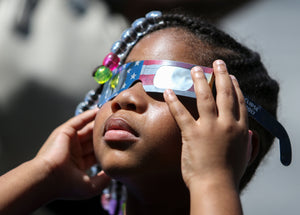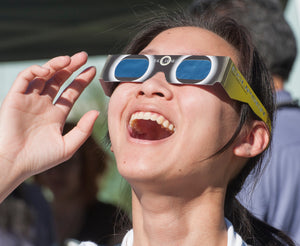Blog
Affiliate Partnership Highlight

We are delighted to feature SungazeGlasses.com, one of our latest affiliate partners. The owner, Adam Walters, an expert in website design and search engine optimization, has integrated a remarkable strategy to magnify both our brands' reach and revenue streams. Adam is also the driving force behind Muon Marketing, his own digital marketing company, which specializes in executing data-driven strategies for a variety of clients.
A notable aspect of our partnership with SungazeGlasses.com is their adept use of content to target what users search for on prominent search engines. Their strategic use of articles exemplifies the efficacy of their keyword targeting and content creation.
For instance, in anticipation of the highly-awaited 2024 Cleveland total solar eclipse, they crafted an article titled "Cleveland Eclipse 2024: Times, Safety & More." This targeted approach ensures that the content ranks high in search engine results for phrases that are likely to be sought after by potential consumers in those areas.
In doing so, SungazeGlasses.com succeeds in not only attracting a high volume of organic traffic but also providing valuable information to its audience.
In addition to their SEO eclipse strategies, SungazeGlasses.com employs an extensive email outreach campaign targeted at businesses situated in the path of totality for the upcoming solar eclipse. Through this outreach, they inform the businesses about the spectacular nature of the event and its potential to attract a large audience in need of specialized eclipse glasses.
Adam Walters is planning to take his marketing strategies to the ground by returning to his home state of Ohio in March. He intends to station himself in high-traffic areas such as grocery stores and sporting events to sell the eclipse glasses directly to consumers.
Additionally, Adam will approach local businesses to inform them of the impending total solar eclipse and the lucrative opportunity to sell eclipse glasses to their customers. Not stopping at pure commercial activities, Adam will also make generous donations of eclipse glasses to local libraries and schools. This will not only bring about goodwill within the community but is also expected to funnel more traffic to both his and our website, thereby increasing the potential for more affiliate income.
Seize the Opportunity With Our Affiliate Program
Seize a lucrative opportunity by joining the EclipseGlasses.com Affiliate Program. By signing up, you receive a unique URL, acting as your gateway to earn a 10% commission on every sale referred.
The seamless integration facilitates effortless redirection to EclipseGlasses.com, ensuring accurate tracking and rewarding of your referral efforts. Capitalize on this celestial event by signing up for the affiliate program, and start a journey toward financial growth and community engagement.
- Jason Lewin
American Paper Optics Launches Back-to-School Education Campaign

The goal is to raise awareness for the two upcoming eclipses, including the October 14, 2023 Annular Eclipse and April 8, 2024 Total Solar Eclipse, through a multi-media campaign that will include books, webinars, podcasts, apps, social media, videos and more.
- Jason Lewin
COUNTDOWN AT AMERICAN PAPER OPTICS STARTS NOW FOR 2024 ECLIPSE
By Jane Roberts, Daily Memphian Updated: April 08, 2023 9:16 PM CT | Published: April 08, 2023 3:03 PM CT

A year from today — April 8, 2024 — one of the biggest solar eclipses that many adults will experience in their lifetimes will cross the North American skies.
Getting ready for it is nothing short of an Olympic feat for John Jerit, president of American Paper Optics in Bartlett. The company is the largest manufacturer of 3D glasses in the world.
“I hope to sell 75 million glasses. We’ve already got orders shipped or sold (for) 26 million,” he says, against a sea of 3D glasses staring a vacant gaze across his showroom.
There are glasses with a cutout of the moon moving into the sun; another pair is framed with a die-cut cowboy hat tilted at a rakish angle. And then there are the colors and the branding for planetariums, zoos, businesses, foundations, even St. Jude Children’s Research Hospital.
All of them are for this day next year, a shining tribute to the magic and power of the sun and the stunning, eerie sobriety when it goes dark.
After next April, the next total eclipse in the U.S. won’t come until 2045.
The last time this part of the world was activated for an eclipse was in 2017, the Great American Eclipse. Jerit remembers it like it was the last full moon.
He sold 45 million pairs of 3D glasses for an estimated 12 million close enough to the totality to need eye protection.
The eclipse on his mind now will start in Mexico and run in a northeasterly line through Canada. It will take in tens of millions of people and hit some large U.S. cities, including Dallas; Columbus, Ohio; Cleveland, Ohio; and Buffalo, New York, before it heads into the low-population territory of northern Vermont, New Hampshire and Maine.
“It will cross through 13 different states. This time (as compared to 2017), the event is going to be longer (some 4.5 minutes in some locations), and the path is going to be bigger,” said Jason Lewin, chief marketing officer for American Paper Optics.

“This time, everyone knows what’s going on. So with the three countries, you have a potential 500 million being able to see it.”
That’s a lot of potential customers. And headaches too.
In 2017, millions of American Paper Optics glasses sold by Amazon vendors were counterfeit copies made by Chinese pirates.
There was no way to know if the film “lenses” that protect the eyes from the dangerous glare were safe. Amazon canceled vendors and more popped up, Jerit said.
In the end, Amazon had no choice but to cancel all the unknown vendors selling glasses, which created huge last-minute orders, thousands in a day, for American Paper Optics.
To preempt as much anxiety as it can, American Paper Optics has manufactured all its Christmas glasses (about 2 million pairs) and other promotions, saving its equipment for the large press of work this fall.
“We’re marketing and selling out there,” Jerit said. “And we do a lot of direct mail,” including 10,000 fliers that went out this week to Fortune 500 companies, agencies and drugstore chains.
The plot for American Optics is complicated for the next 12 months because there will be a lesser eclipse in the western U.S. on Oct. 14, 2023. In the path of annularity, about 118 -137 miles wide, viewers will see the sun’s ring of fire around the moon.
That will pale next to the total eclipse next April 8.

Memphis, just east of the path of totality, will see it at about 97%.
Jerit, who’s come to appreciate this eclipsing science rather wryly, has taken to calling the October eclipse the Johnny Cash (for Ring of Fire) and the second, the Bonnie Tyler (Total Eclipse of the Heart).
There’s a reason for the wry. Two eclipses may encourage people to save their glasses for the second event, which is one thing.
But it may also mean there will be two big ordering seasons, the second happening at the last minute when they can’t find the saved pair or remember they never ordered.
Jerit doesn’t have much gray hair, but the thought of that makes what he does have grow a little thinner.
He’s been in this business for 33 years, and he knows something about human behavior when it comes to 3D glasses. And there is some history.
Starting in 2017, lots of people weren’t paying attention, he says, and didn’t order on time, creating a heartache of a rush a week out or less.
“Right now, we’re getting 50 orders a day. But in 2017, in the month leading up to it, we started getting 10,000, 11,000, 13,000 orders a day in that last couple of weeks,” Lewin said.
Jerit thinks people learned their lessons, including a few retailers who missed the chance at sales completely in 2017.
“They’re all on board now,” Jerit says.
The issue is getting them to feel the urgency he does. The glasses are sold in kiosks and in end-cap spaces designed by the customer.
If they don’t get their designs in, American Optics can’t process and ship the order.
“Why don’t you guys buy these glasses for half the price and stick them in one of our little flowerpot tubes and put them on your counter and quit worrying about everything else,” Jerit half mumbles to himself. “Because that is how they are going to sell. We’ve already proven that.”
The company makes other kinds of specialty glasses, including decoders that reveal hidden messages for product promotions, glasses with custom frames and glasses that create special effects when trained on fireworks or Christmas lights.
Its sales of solar eclipse glasses account for about 10% of revenue, Jerit said. Half of the revenue comes from sales to companies that use specialty glasses for promotions, and 40% comes from retail sales of the specialty glasses.

The other challenge is convincing retailers to put up their displays right after Labor Day to catch the October event and leave them up through the busy Christmas season and after for April 8 event.
Please trust us,” he says. “We know what we’re talking about. They won’t.”
If the displays are taken down, they will have to be remade for the second buying spree, Jerit says, shaking his head.
Part of the sales talk is telling people how to make the most of the April 8 event, including getting themselves to the place where it will last the longest. Jerit does not advise driving to the path of totality on the day of the eclipse, predicting the roads and freeways will be clogged with people.
“Fly to wherever you’re going a couple of days before and just turn into a vacation. And it’s a Monday, then come back on Tuesday.”
- Jason Lewin
Two Minutes of Magic: The 2020 Total Solar Eclipse
Alexandra Schonfeld

In a year that has been filled with many dark spots, the total solar eclipse gave people across South America a reason to look up (with their safe solar eclipse glasses).
The only total solar eclipse of 2020 occurred Monday and was visible in full across a small section of the South Pacific, Chile, Argentina and the southern Atlantic Ocean.
Onlookers in a wider region in the Pacific, southern South America and Antarctica were able to see a partial eclipse, according to Space.com. The last total solar eclipse was in July 2019 and was dubbed the "Great South American Eclipse" as it was almost exclusively visible in South America — much like today's event.
The next time a full solar eclipse is expected is in December 2021, over Antarctica.
What is a solar eclipse? It occurs when the moon passes in front of the sun from the viewpoint of earth. A total solar eclipse happens when the entirety of the sun is covered by the moon.
It was a sight to see around Chile and Argentina as people gathered, decked out in masks, rain ponchos and solar eclipse glasses provided by American Paper Optics — a combination beyond imagination, to see this event that happens somewhere on earth once every few years. Despite heavy rain that poured down hours before the eclipse was set to be visible in parts of Chile, it cleared enough for the show to be at least partially visible to onlookers.
From each viewing spot, the eclipse lasted for as long as a bit over two minutes to as short as six seconds, according to Space.com. The moon began passing in front of the sun around 9 a.m. EST with the first sight of a total eclipse beginning about an hour and a half later.
And in a year of extraordinary news each day, it's almost no surprise that on the same day of the total solar eclipse, is also the day when the Geminid meteor shower peaked. During the evening between December 13 and 14, the shower was most visible from earth. The best time to see the show would have been around 2 a.m., according to EarthSky.org.
- Jason Lewin
Nuevamente es momento de los anteojos de eclipse para American Paper Optics

MEMPHIS, Tennessee--(BUSINESS WIRE)--American Paper Optics, la compañía de fabricación de anteojos 3D más grande del mundo y el mayor proveedor de anteojos de eclipse para el eclipse total de Estados Unidos de 2017, se ha estado preparando los últimos 18 meses para el próximo gran eclipse que cruzará América del Sur el 2 de julio. La compañía ya ha producido más de 2 millones de anteojos, así como un folleto de 32 páginas, videos y otros materiales promocionales para el eclipse que recorrerá Chile y Argentina en unos pocos meses.
- Alexander Risse




